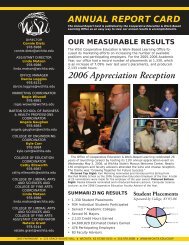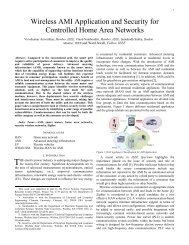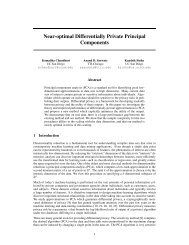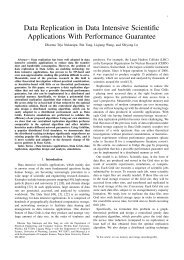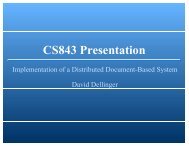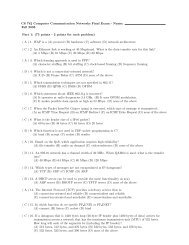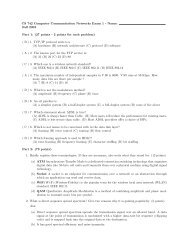CS 540 - Operating Systems - Test 2 - Name: Date: Friday ...
CS 540 - Operating Systems - Test 2 - Name: Date: Friday ...
CS 540 - Operating Systems - Test 2 - Name: Date: Friday ...
Create successful ePaper yourself
Turn your PDF publications into a flip-book with our unique Google optimized e-Paper software.
<strong>CS</strong> <strong>540</strong> - <strong>Operating</strong> <strong>Systems</strong> - <strong>Test</strong> 2 - <strong>Name</strong>:<br />
<strong>Date</strong>: <strong>Friday</strong>, November 19, 2004<br />
Part 1: (33 points - 3 points for each problem)<br />
( C ) 1. Which strategy is used in the Banker’s algorithm for dealing with deadlocks?<br />
(A) Deadlock Ignorance (B) Deadlock Detection (C) Deadlock Avoidance (D) Deadlock Prevention<br />
( D ) 2. Which deadlock condition does ordering resources numerically attack?<br />
(A) Mutual exclusion (B) Hold and wait (C) No preemption (D) None of the above<br />
( B ) 3. Which of the memory allocation schemes are not subject to internal fragmentation?<br />
(A) Multiple Contiguous Fixed Partitions (B) Segmentation (C) Paging (D) None of above<br />
( D ) 4. A system has 256 MB memory. The time to read or write a 32-bit memory word is 10 nsec.<br />
Assume the total processes take 3 times of memory taken by holes. What is the time needed to<br />
eliminate holes by compaction?<br />
(A) 167.772 ms (B) 335.544 ms (C) 503.316 ms (D) None of the above<br />
( A ) 5. A computer with physical address space of 2 24 words has the frame size of 4096 (2 12 ) words.<br />
If the hexadecimal physical address is 123456, the frame number in hexadecimal would be:<br />
(A) 123 (B) 456 (C) 1234 (D) 123456<br />
( D ) 6. If there are 128K pages and the page size is 32K words, the length of logical address is:<br />
(A) 24 bits (B) 28 bits (C) 30 bits (D) 32 bits<br />
( C ) 7. A system has 64 virtual pages mapping into 16 physical frames in the following equation:<br />
frame number = page number % 16. Each page has 1K words. If the virtual address is 1010101000111101,<br />
the physical address would be:<br />
(A) 11001000111101 (B) 10101010001111 (C) 10101000111101 (D) None of the above<br />
( A ) 8. A machine with 512 (2 9 ) MB memory has a 32-bit memory word. The frame size is 8 K (2 13 ).<br />
words. How many bits are used to indicate the frame number?<br />
(A) 14 bits (B) 16 bits (C) 20 bits (D) None of the above<br />
( A ) 9. A system with a 32-bit virtual address. Each page size is 16 KB words. Each table entry takes<br />
4 bytes. What is the size of the page table?<br />
(A) 1 MB (B) 2 MB (C) 4 MB (D) 8 MB<br />
( B ) 10. The modified (dirty) bit cannot be used for the purpose of:<br />
(A) Implementing NRU page replacement algorithm<br />
(B) Dynamic allocation of memory used by one process to another<br />
(C) Reducing the average time required to service page faults<br />
(D) None of the above.<br />
( D ) 11. Which statement about segmentation is false?<br />
(A) There are many linear address spaces.<br />
(B) The total address space can exceed the size of physical memory.<br />
(C) Sharing of procedures between users is facilitated.<br />
(D) None of the above
Part 2: (67 points)<br />
1. (8 pts.) P is a set of processes. R is a set of resources. E is a set of request or assignment edges. The<br />
sets P, R, and E are as follows:<br />
P = {P 1 , P 2 , P 3 }, R = {R 1 , R 2 , R 3 },<br />
E = {P 1 → R 1 , P 1 → R 2 , P 2 → R 2 , P 2 → R 3 , P 3 → R 2 , P 3 → R 3 , R 1 → P 2 , R 2 → P 2 , R 3 → P 1 }.<br />
R 1 has one instance. R 2 has two instances. R 3 has one instances.<br />
(a) Draw the resource-allocation graph.<br />
(b) Is there any deadlock in this situation? Briefly Explain.<br />
Ans:<br />
(a) The resource-allocation graph is shown as follows:<br />
✛✘<br />
✛✘<br />
✛✘<br />
P1<br />
P2<br />
P3<br />
✚✙ ✚✙ ✚✙<br />
◗❳❳2 ❳ ◗◗◗◗◗<br />
❳ ❳❳ ✻◗ ✑<br />
❳ ◗◗◗◗◗◗ ✑<br />
❳❳<br />
❳ ✑<br />
❳❳ ✑<br />
❄✑ ✑✑✑✑✑✑✑✸ ❳ ✑ ❳<br />
◗<br />
❄ ✑<br />
❳ ❳❳<br />
✑✰<br />
❳❄<br />
R1 R2 R3<br />
(b) Consider the resource-allocation graph. There are four cycles in the system:<br />
P1 → R1 → P2 → R3 → P1, P1 → R2 → P2 → R3 → P1, P2 → R2 → P2,<br />
P2 → R3 → P1 → R1 → P2.<br />
P1 cannot finish because P1 needs R1 and R2 but can only acquire R2 while R1 is held by P2.<br />
P2 cannot finish because P2 needs R2 and R3 but can only acquire R2 while R3 is held by P1.<br />
P3 cannot finish because P3 needs R1 and R3 but can only acquire R2 while R3 is held by P1.<br />
P1, P2, and P3 cannot progress. The deadlock occurs.<br />
2. (a) (2 pts.) What is Belady’s anomaly?<br />
(b) (2 pts.) Give two page-replacement algorithms that do not suffer from Belady’s anomaly.<br />
(c) (3 pts.) What is the working set model?<br />
(d) (2 pts.) What is the cause of thrashing?<br />
(e) (2 pts.) How does the system detect thrashing?<br />
Ans:<br />
(a) more page frames might not always have fewer page faults. This is called Belady’s anomaly.<br />
(b) LRU and optimal algorithms suffer from Belady’s anomaly.<br />
(c) Paging systems keep each process. working set in memory before letting the process run. This<br />
approach is called the working set model.<br />
(d) Thrashing is caused by under-allocation of the minimum number of pages read required by a<br />
process, forcing it to continuously page fault.<br />
(e) The system can detect thrashing by evaluating the level of CPU utilization as compared to the<br />
level of multiprogramming.
3. (10 pts.) Consider a swapping system in which memory consists of <strong>540</strong>K as shown below:<br />
xxx P3 xxxx P5 xxxxx P7 xx where xx.. indicates the unused memory.<br />
0 60 140 220 320 420 500 <strong>540</strong><br />
Note that P3, P5, and P7 are processes in memory. Assume that process P3 was just swapped into<br />
memory and that new processes arrive in the order P8, P9, P10, P11 and are of size 70K, 50K, and<br />
80K, 40K respectively. How would each of the first-fit, next-fit, best-fit, and worst-fit algorithms place<br />
processes of P8, P9, P10, and P11? If a process won’t fit, write ’out of memory’ in the appropriate slot.<br />
Ans:<br />
first fit: P9 x P3 P8 x P5 P10 x P7 P11<br />
0 50 60 140 210 220 320 400 420 500 <strong>540</strong><br />
next fit: xxx P3 P8 x P5 P9 P11 x P7 xx P10: out of memory<br />
0 60 140 210 220 320 370 410 420 500 <strong>540</strong><br />
best fit: P9 x P3 P8 x P5 P10 xx P7 P11<br />
0 50 60 140 210 220 320 400 420 500 <strong>540</strong><br />
worst fit: P11 x P3 P9 x P5 P8 xx P7 xx P10: out of memory<br />
0 40 60 140 190 220 320 390 420 500 <strong>540</strong><br />
4. (10 pts.) The time required to read a word in memory (including the time to access associative memory)<br />
is 80 nanoseconds when the page number is in the associative memory. The access time of associative<br />
memory is 10 nanoseconds.<br />
(a) Find a formula that expresses the effective access time as a function of the hit ratio.<br />
(b) What hit ratio is needed to achieve the effective access time to 101 nanoseconds?<br />
Ans:<br />
(a) Let e and t be the access time to associative memory and ordinary memory respectively.<br />
Assume the hit ratio be h.<br />
e + t = 80, 10 + t = 80, t = 70<br />
Effective Access Time = h×80+(1−h)×(10+2×70) = 80h+(1−h)×150 = 80h+150−150h =<br />
150 − 70h<br />
(b) 150 − 70h ≤ 101, 70h ≥ 49, h ≥ 70% The hit ratio should be 70%.<br />
5. (8 pts.) A computer has four page frames. The time of loading, time of last access, and the R and M<br />
bits for each page are as shown below (the times are in clock ticks):<br />
Page Loaded Last Referenced R M<br />
0 140 270 1 1<br />
1 230 260 0 1<br />
2 126 280 1 0<br />
3 162 265 0 0<br />
(a) Which page will NRU replace?<br />
(b) Which page will FIFO replace?<br />
(c) Which page will LRU replace?<br />
(d) Which page will second chance replace?<br />
Ans:<br />
(a) Page 3 because R and M bits are 0.<br />
(b) Page 2 because it is oldest (loaded at 126).<br />
(c) Page 1 because is least recently referenced (referenced at 260).<br />
(d) Page 3 because it is oldest and not referenced (loaded at 162 and R = 0).
6. (8 pts.) A small computer has five page frames. At the first clock tick, the R bits are 11001 (page 2<br />
and 3 are 0). A subsequent clock ticks, the values are 10110, 00101, 00101, 11000, 01011, 10101, and<br />
11001<br />
(a) If the aging algorithm is used with an 8-bit counter, give the values of the counters after the last<br />
tick.<br />
(b) Which page would be selected to be removed from memory?<br />
Ans:<br />
(a)<br />
R bits Page 0 Page 1 Page 2 Page 3 Page 4<br />
11001 10000000 10000000 00000000 00000000 10000000<br />
10110 11000000 01000000 10000000 10000000 01000000<br />
00101 01100000 00100000 11000000 01000000 10100000<br />
00101 00110000 00010000 11100000 00100000 11010000<br />
11000 10011000 10001000 01110000 00010000 01101000<br />
01011 01001100 11000100 00111000 10001000 10110100<br />
10101 10100110 01100010 10011100 01000100 11011010<br />
11001 11010011 10110001 01001110 00100010 11101101<br />
(b) Page 3 has the smallest value. It will be evicted.<br />
7. (12 pts.) Suppose there are 8 virtual pages and 4 page frames. Determine the number of page faults<br />
that will occur with the reference string 0 2 3 1 4 2 5 6 0 1 3 2 4 7 1 2, if the page frames are initially<br />
empty, using each of the following page replacement algorithms: (a) FIFO (b) LRU (c) Optimal.<br />
Ans:<br />
(a) FIFO - 14<br />
0 2 3 1 4 2 5 6 0 1 3 2 4 7 1 2<br />
0 2 3 1 4 4 5 6 0 1 3 2 4 7 1 1<br />
0 2 3 1 1 4 5 6 0 1 3 2 4 7 7<br />
0 2 3 3 1 4 5 6 0 1 3 2 4 4<br />
0 2 2 3 1 4 5 6 0 1 3 2 2<br />
P P P P P P P P P P P P P P<br />
(b) LRU - 14<br />
0 2 3 1 4 2 5 6 0 1 3 2 4 7 1 2<br />
0 2 3 1 4 2 5 6 0 1 3 2 4 7 1 2<br />
0 2 3 1 4 2 5 6 0 1 3 2 4 7 1<br />
0 2 3 1 4 2 5 6 0 1 3 2 4 7<br />
0 2 3 1 4 2 5 6 0 1 3 2 4<br />
P P P P P P P P P P P P P P<br />
(c) Optimal - 10<br />
0 2 3 1 4 2 5 6 0 1 3 2 4 7 1 2<br />
0 0 0 0 0 0 0 0 0 0 0 0 0 0 0 0<br />
2 2 2 2 2 2 2 2 2 2 2 2 2 2 2<br />
3 3 4 4 5 6 6 6 3 3 4 7 7 7<br />
1 1 1 1 1 1 1 1 1 1 1 1 1<br />
P P P P P P P P P P



